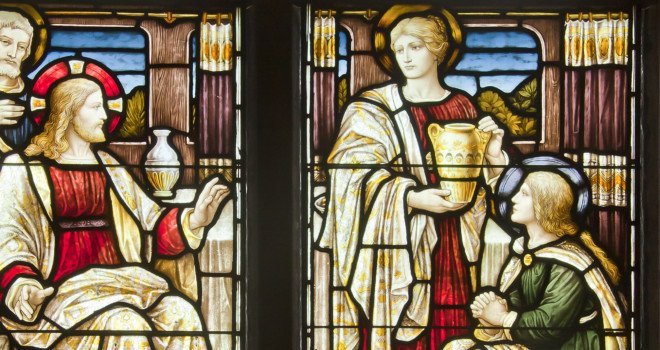You may be reading this because you’re skeptical that life of Martha could guide you to inner peace.
Everyone knows that our Lord called her anxious and worried.
Shouldn’t Mary of Bethany have a guide to inner peace?
Isn’t she supposed to be the peaceful one?
Yes, but to Mary prayer comes naturally, or at least that’s what we see in the gospel stories involving the family of Martha, Mary and Lazarus.
Martha, on the other hand, evolves from anxious to peaceful, so her life can guide us along this same path.
But first, we’ll need to understand the interpretive key that unlocks the six insights from Mary’s life.
Free bonus: I prepared three meditations on the life of Martha to help you solidify the lessons in this article. Click here to receive them in your inbox over the next five days.
Our Prayer Overemphasizes Our Head at the Expense of Our Heart
You can probably relate to these words: “My prayer is more in my head than my heart.” because distracting thoughts prevent us from entering into our heart.
While we know that we need to avoid distractions, we may give them more importance than necessary because we believe that the head is more important than it really is in prayer.
Recognizing this temptation, which comes at the expense of our heart, the Catechism provides this advice: “To set about hunting down distractions would be to fall into their trap, when all that is necessary is to turn back to our heart.”
Martha Shows Us Where an Overemphasis on the Head Can Lead
In the gospels, the home is a symbol of the person, which is why we apply the words of the centurion to ourselves at every mass: “Lord, I am not worthy to receive you under my roof…” So, we can view the different characters in the home of Martha and Mary as different parts of the person. Martha represents the head and Mary, the heart. (Jesus is Himself ;).
When the head exerts too much control, it bosses around Jesus and the heart: “Lord, do you not care that my sister has left me by myself to do the serving? Tell her to help me.” This frustrates the heart, leading it to grow dormant until it comes back and overwhelms the head.
It may not seem obvious that trying to control our heart is also trying to control Jesus, but consider that our heart contains the highest gift from Jesus: our ability to love. Indeed, “God is a God of the human heart” as St. Francis de Sales says.
If you’d like to go deeper into this scene and the two other Martha and Mary scenes from the gospel, consider using these three meditations I wrote.
But, If Our Heart Is in Charge Then Nothing Will Get Done!
Or, so the head thinks. Martha tries to control Mary because Martha is afraid that the serving won’t get done and Jesus’s visit will be a disaster. Similarly, our head comes up with its own priorities independent of Jesus and promptly falls in love with them. This is pride.
Martha also castigates Mary because she is breaking social convention by sitting at the feet of Jesus, which was normally only something that men would do. In the same way, our head fears that our heart will lead us to an embarrassing place outside the bounds of social convention.
Like Martha, we are “burdened with much serving” and like Martha that serving can all be intended for Jesus. We can believe that, “with all I have to do for God, I don’t have time to sit around and do nothing.” If that nothing means ignoring God, then you’re right, but if that nothing is sitting at His feet in wonderment, then get to it!
The Head Is at the Service of the Heart
You may have heard that as prayer develops it simplifies and becomes less about thought (the head) and more about love (the heart). The Way of the Pilgrim, a spiritual classic on the Jesus prayer, describes the fundamental transition in prayer as going “from the mind into the heart.” While this transition is “a pure grace” in the words of Fr. Jacque Philippe, if we don’t know that our prayer is headed towards the heart, then we won’t give the heart the priority it deserves before we receive this grace. It can be important to remember the words of St. Teresa of Avila, “prayer doesn’t consist in much thinking, but in much loving.”
6 Insights From the Life of Martha That Will Help Your Prayer Move From Your Head to Your Heart
- Receive Jesus into your house. Even when you’re anxious about the responsibilities involved and skeptical that you will have the help you need, receive Him like Martha did.
- Speak truthfully to Jesus. If you feel like Martha felt, then tell Jesus. You will receive correction faster than if you try to hide your true self from him. Although we don’t have Jesus in our living room to give us a correction, we do have his Word, church teaching and the help of others.
- Embrace suffering. Martha doesn’t rebel against her brother’s death by blaming Jesus. Instead, Martha’s suffering has united her to Mary, which we see because they both say the same thing to Jesus: “If you had been here, my brother would not have died.” When we embrace suffering, we can reconnect with our heart, which is more vocal during difficult times.
- Go to Jesus with your mind to bring Him back to your heart. After Lazarus died, “When Martha heard that Jesus was coming, she went to meet him.” In the same way, we use our minds at the start of prayer to imagine Jesus for the purpose of “bringing Him to our heart,” or arousing our affections.
- Make an act of faith in Jesus. Before coming to Bethany to raise Lazarus and console Mary, Jesus asks Martha if she believes. She says: “Yes, Lord. I have come to believe that you are the Messiah, the Son of God.” Likewise, before Jesus will come into our heart (Mary) and raise what is dead in us (Lazarus), we must believe.
- Put your head at the service of your heart. In John Chapter 12, one of my favorite passages in scripture, Martha is hosting again, but she simply “served,” allowing Mary to “anoint the feet of Jesus and dry them with her hair.”
✠
This article originally appeared on JoyOfDevotion.org and appears here with kind permission












